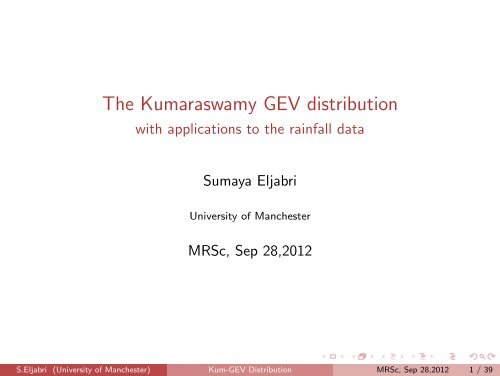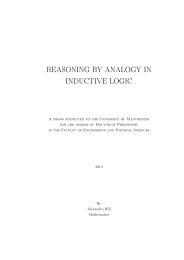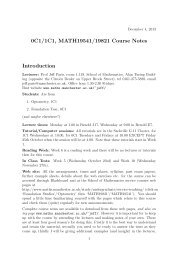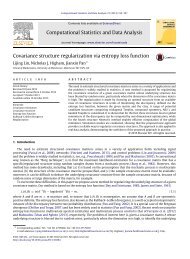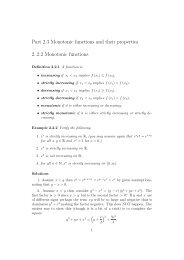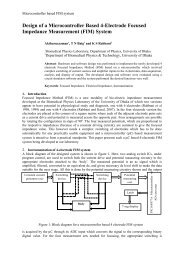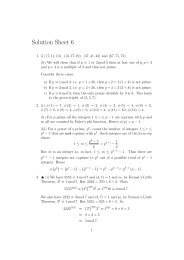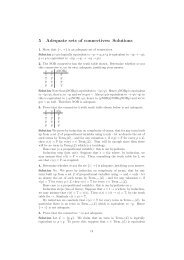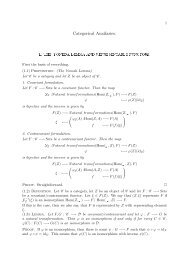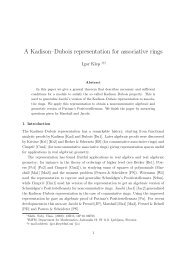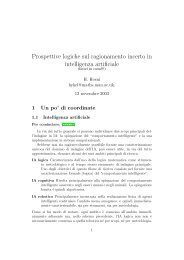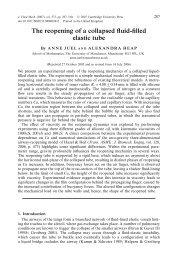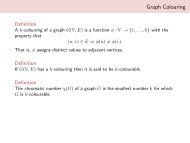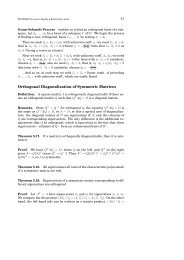The Kumaraswamy GEV distribution - University of Manchester
The Kumaraswamy GEV distribution - University of Manchester
The Kumaraswamy GEV distribution - University of Manchester
You also want an ePaper? Increase the reach of your titles
YUMPU automatically turns print PDFs into web optimized ePapers that Google loves.
<strong>The</strong> <strong>Kumaraswamy</strong> <strong>GEV</strong> <strong>distribution</strong><br />
with applications to the rainfall data<br />
Sumaya Eljabri<br />
<strong>University</strong> <strong>of</strong> <strong>Manchester</strong><br />
MRSc, Sep 28,2012<br />
S.Eljabri (<strong>University</strong> <strong>of</strong> <strong>Manchester</strong>) Kum-<strong>GEV</strong> Distribution MRSc, Sep 28,2012 1 / 39
1 Generalized Extreme Value <strong>distribution</strong><br />
<strong>GEV</strong> <strong>distribution</strong><br />
Applications <strong>of</strong> <strong>GEV</strong> <strong>distribution</strong><br />
2 DB-PDF<br />
DB-PDF<br />
Applications <strong>of</strong> DB-PDF<br />
3 Kum-<strong>GEV</strong> <strong>distribution</strong><br />
Sub-models <strong>of</strong> the Kum-<strong>GEV</strong> <strong>distribution</strong><br />
PDF <strong>of</strong> the Kum-<strong>GEV</strong> <strong>distribution</strong><br />
HRF <strong>of</strong> the Kum-<strong>GEV</strong> <strong>distribution</strong><br />
Simulation Study<br />
Applications<br />
S.Eljabri (<strong>University</strong> <strong>of</strong> <strong>Manchester</strong>) Kum-<strong>GEV</strong> Distribution MRSc, Sep 28,2012 2 / 39
Why Study Extremes?<br />
S.Eljabri (<strong>University</strong> <strong>of</strong> <strong>Manchester</strong>) Kum-<strong>GEV</strong> Distribution MRSc, Sep 28,2012 3 / 39
Why Study Extremes?<br />
S.Eljabri (<strong>University</strong> <strong>of</strong> <strong>Manchester</strong>) Kum-<strong>GEV</strong> Distribution MRSc, Sep 28,2012 4 / 39
Extreme Events<br />
Q: What does it mean to be an ”Extreme Event”?<br />
A: It depends whom you ask:<br />
Financial analysts: ”Shocks” to a time series (Market Crash)<br />
Insurance companies: Costly Phenomena (Hurricanes)<br />
Meteorologists: Rare Weather Phenomena.<br />
Applied Mathematicians: Extremes <strong>of</strong> Gaussian/other processes, Large Deviations<br />
Statisticians (like me!): Extreme Value <strong>The</strong>ory.<br />
Many possible answers!<br />
S.Eljabri (<strong>University</strong> <strong>of</strong> <strong>Manchester</strong>) Kum-<strong>GEV</strong> Distribution MRSc, Sep 28,2012 5 / 39
Generalized Extreme Value <strong>distribution</strong><br />
<strong>The</strong> Generalized extreme value (<strong>GEV</strong>) <strong>distribution</strong> was proposed by Jenkinson(1955). Since<br />
then, it become one <strong>of</strong> the most widely applied models for univariate extreme values. <strong>The</strong> cdf<br />
and pdf <strong>of</strong> the <strong>GEV</strong> <strong>distribution</strong> are defined as<br />
Gξ,µ,σ(x) = exp(−u),<br />
Where u = {1 + ξ(x − µ)/σ} −1/ξ > 0, µ, ξ ∈ R and σ > 0.<br />
Three Types <strong>of</strong> EVD<br />
gξ,µ,σ(x) = σ −1 u 1+ξ exp(−u). (1)<br />
<strong>The</strong> parameter ξ determines tail behavior and is difficult to estimate in practice.<br />
ξ < 0 : Negative Weibull Distribution<br />
ξ = 0 Gumbel Distribution<br />
ξ > 0 Frechét Distribution<br />
S.Eljabri (<strong>University</strong> <strong>of</strong> <strong>Manchester</strong>) Kum-<strong>GEV</strong> Distribution MRSc, Sep 28,2012 6 / 39
Applications <strong>of</strong> <strong>GEV</strong> <strong>distribution</strong><br />
<strong>GEV</strong> <strong>distribution</strong> cover most fields <strong>of</strong> researches<br />
science and engineering<br />
analysis <strong>of</strong> annual maximum rainfall, analysis <strong>of</strong> extreme floods, analysis <strong>of</strong> regional earthquake<br />
records, analysis <strong>of</strong> high level ozone concentrations, analysis <strong>of</strong> extreme maximum and minimum<br />
temperatures, analysis <strong>of</strong> ocean climate, analysis <strong>of</strong> air pollution data.<br />
medicine<br />
characteristics <strong>of</strong> Alzheimer’s disease,testing multiple gene interactions.<br />
For more details on <strong>GEV</strong> <strong>distribution</strong>, its theory and further applications, we refer to<br />
see(Leadbetter et al. (1987), Embrechts et al. (1997), Castillo et al. (2005), and Resnick<br />
(2008)).<br />
However, the <strong>GEV</strong> <strong>distribution</strong> has been misused in too many areas; Buishand (1991), Tolikas<br />
and Gettinby (2009), So, there is a need for generalizations <strong>of</strong> the <strong>GEV</strong> <strong>distribution</strong>.<br />
S.Eljabri (<strong>University</strong> <strong>of</strong> <strong>Manchester</strong>) Kum-<strong>GEV</strong> Distribution MRSc, Sep 28,2012 7 / 39
Double- Bounded probability density function (DB-PDF)<br />
<strong>Kumaraswamy</strong> (1980)proposed a two parameters <strong>distribution</strong> with double-bounded<br />
support known as DB-PDF and later so-called <strong>The</strong> <strong>Kumaraswamy</strong> <strong>distribution</strong>.<br />
FKum(z) = 1 −<br />
�<br />
1 −<br />
fKum(z) =<br />
1<br />
a b<br />
(d − c)<br />
� �a�b z − c<br />
;<br />
d − c<br />
� �a−1 � � �a�b−1 z − c<br />
z − c<br />
1 −<br />
.<br />
d − c<br />
d − c<br />
Making the linear transformation X = Z−c<br />
. We can obtain the standard <strong>Kumaraswamy</strong><br />
b−c<br />
<strong>distribution</strong>. <strong>The</strong> pdf <strong>of</strong> the latter<br />
FKum(x, a, b) = 1 − (1 − x a ) b ; x ∈ (0, 1)<br />
fKum(x, a, b) = abx a−1 (1 − x a ) b−1 ; x ∈ (0, 1)<br />
<strong>Kumaraswamy</strong> <strong>distribution</strong> is very similar to the beta <strong>distribution</strong>, but this formula has<br />
some advantages over beta <strong>distribution</strong>. Jones(2009) explored the background <strong>of</strong> the<br />
Kum <strong>distribution</strong> and, more importantly, made clear some similarities and differences<br />
between the beta and Kum <strong>distribution</strong>s.<br />
S.Eljabri (<strong>University</strong> <strong>of</strong> <strong>Manchester</strong>) Kum-<strong>GEV</strong> Distribution MRSc, Sep 28,2012 8 / 39
Double- Bounded probability density function (DB-PDF)<br />
<strong>The</strong> Kum pdf is unimodal, uniantimodal, increasing, decreasing or constant depending on the<br />
values <strong>of</strong> its parameters<br />
S.Eljabri (<strong>University</strong> <strong>of</strong> <strong>Manchester</strong>) Kum-<strong>GEV</strong> Distribution MRSc, Sep 28,2012 9 / 39
Double- Bounded probability density function (DB-PDF)<br />
<strong>The</strong> Kum pdf is unimodal, uniantimodal, increasing, decreasing or constant depending on the<br />
values <strong>of</strong> its parameters<br />
S.Eljabri (<strong>University</strong> <strong>of</strong> <strong>Manchester</strong>) Kum-<strong>GEV</strong> Distribution MRSc, Sep 28,2012 10 / 39
Double- Bounded probability density function (DB-PDF)<br />
<strong>The</strong> Kum pdf is unimodal, uniantimodal, increasing, decreasing or constant depending on the<br />
values <strong>of</strong> its parameters<br />
S.Eljabri (<strong>University</strong> <strong>of</strong> <strong>Manchester</strong>) Kum-<strong>GEV</strong> Distribution MRSc, Sep 28,2012 11 / 39
Applications <strong>of</strong> DB-PDF<br />
<strong>The</strong> <strong>Kumaraswamy</strong> <strong>distribution</strong> does not seem to be very familiar to statisticians. <strong>The</strong><br />
best example <strong>of</strong> an application <strong>of</strong> the Kum <strong>distribution</strong> is the model <strong>of</strong> the storage volume<br />
<strong>of</strong> reservoir, see Fletcher and Ponnambalam (1996).<br />
In hydrology, it has been received considerable interest see, for example, Ponnambalam et<br />
al. (2001) and Ganji et al. (2006). According to Nadarajah (2008), many papers in the<br />
hydrological literature have used this <strong>distribution</strong> because it is deemed as a “better<br />
alternative” to the beta <strong>distribution</strong>, Koutsoyiannis and Xanthopoulos (1989).<br />
S.Eljabri (<strong>University</strong> <strong>of</strong> <strong>Manchester</strong>) Kum-<strong>GEV</strong> Distribution MRSc, Sep 28,2012 12 / 39
Kum-<strong>GEV</strong> <strong>distribution</strong><br />
By combining the works <strong>of</strong> <strong>Kumaraswamy</strong> (1980) and Jones (2009), Cordeiro and de Castro<br />
(2011) defined the cumulative <strong>distribution</strong> function <strong>of</strong> the Kum G (Kum-G) <strong>distribution</strong> by<br />
F (x) = 1 − {1 − G(x) a } b ,<br />
where a > 0 and b > 0 are two additional parameters. <strong>The</strong> probability density function<br />
corresponding to (2) has a very simple form<br />
f (x) = ab g(x) G(x) a−1 {1 − G(x) a } b−1 .<br />
Here, we combine between the Kum <strong>distribution</strong> and <strong>GEV</strong> <strong>distribution</strong>.<br />
cdf and pdf <strong>of</strong> the Kum-<strong>GEV</strong> <strong>distribution</strong>:<br />
where u = (1 + ξ( x−µ<br />
σ ))−1/ξ .<br />
F (x) = 1 − {1 − exp(−au)} b ,<br />
f (x) = σ −1 a b u 1+ξ exp(−au) {1 − exp(−au)} b−1 . (2)<br />
S.Eljabri (<strong>University</strong> <strong>of</strong> <strong>Manchester</strong>) Kum-<strong>GEV</strong> Distribution MRSc, Sep 28,2012 13 / 39
Sub-models <strong>of</strong> the Kum-<strong>GEV</strong> <strong>distribution</strong><br />
<strong>The</strong> Kum-<strong>GEV</strong> <strong>distribution</strong> can be reduced to some sub-models for some special values <strong>of</strong> the<br />
shape parameters.<br />
f (x) = σ −1 a b u 1+ξ exp(−au) {1 − exp(−au)} b−1 .<br />
Parameters<br />
Distribution a b µ σ ξ<br />
Gumbel 1 1 - - → 0<br />
Frechét 1 1 - - > 0<br />
Weibull 1 1 - - < 0<br />
<strong>GEV</strong>D 1 1 - - -<br />
KumG - - - - → 0<br />
KumW - - - - < 0<br />
Table: Some sub-models <strong>of</strong> the Kum-<strong>GEV</strong> <strong>distribution</strong>.<br />
S.Eljabri (<strong>University</strong> <strong>of</strong> <strong>Manchester</strong>) Kum-<strong>GEV</strong> Distribution MRSc, Sep 28,2012 14 / 39
Sub-models <strong>of</strong> the Kum-<strong>GEV</strong> <strong>distribution</strong><br />
<strong>The</strong> Kum-<strong>GEV</strong> <strong>distribution</strong> can be reduced to some sub-models for some special values <strong>of</strong> the<br />
shape parameters.<br />
f (x) = σ −1 a b u 1+ξ exp(−au) {1 − exp(−au)} b−1 .<br />
Parameters<br />
Distribution a b µ σ ξ<br />
Gumbel 1 1 - - → 0<br />
Table: Some sub-models <strong>of</strong> the Kum-<strong>GEV</strong> <strong>distribution</strong>.<br />
S.Eljabri (<strong>University</strong> <strong>of</strong> <strong>Manchester</strong>) Kum-<strong>GEV</strong> Distribution MRSc, Sep 28,2012 15 / 39
Sub-models <strong>of</strong> the Kum-<strong>GEV</strong> <strong>distribution</strong><br />
<strong>The</strong> Kum-<strong>GEV</strong> <strong>distribution</strong> can be reduced to some sub-models for some special values <strong>of</strong> the<br />
shape parameters.<br />
f (x) = σ −1 a b u 1+ξ exp(−au) {1 − exp(−au)} b−1 .<br />
Parameters<br />
Distribution a b µ σ ξ<br />
Gumbel 1 1 - - → 0<br />
Frechét 1 1 - - > 0<br />
Table: Some sub-models <strong>of</strong> the Kum-<strong>GEV</strong> <strong>distribution</strong>.<br />
S.Eljabri (<strong>University</strong> <strong>of</strong> <strong>Manchester</strong>) Kum-<strong>GEV</strong> Distribution MRSc, Sep 28,2012 16 / 39
Sub-models <strong>of</strong> the Kum-<strong>GEV</strong> <strong>distribution</strong><br />
<strong>The</strong> Kum-<strong>GEV</strong> <strong>distribution</strong> can be reduced to some sub-models for some special values <strong>of</strong> the<br />
shape parameters.<br />
f (x) = σ −1 a b u 1+ξ exp(−au) {1 − exp(−au)} b−1 .<br />
Parameters<br />
Distribution a b µ σ ξ<br />
Gumbel 1 1 - - → 0<br />
Frechét 1 1 - - > 0<br />
Weibull 1 1 - - < 0<br />
Table: Some sub-models <strong>of</strong> the Kum-<strong>GEV</strong> <strong>distribution</strong>.<br />
S.Eljabri (<strong>University</strong> <strong>of</strong> <strong>Manchester</strong>) Kum-<strong>GEV</strong> Distribution MRSc, Sep 28,2012 17 / 39
Sub-models <strong>of</strong> the Kum-<strong>GEV</strong> <strong>distribution</strong><br />
<strong>The</strong> Kum-<strong>GEV</strong> <strong>distribution</strong> can be reduced to some sub-models for some special values <strong>of</strong> the<br />
shape parameters.<br />
f (x) = σ −1 a b u 1+ξ exp(−au) {1 − exp(−au)} b−1 .<br />
Parameters<br />
Distribution a b µ σ ξ<br />
Gumbel 1 1 - - → 0<br />
Frechét 1 1 - - > 0<br />
Weibull 1 1 - - < 0<br />
<strong>GEV</strong>D 1 1 - - -<br />
Table: Some sub-models <strong>of</strong> the Kum-<strong>GEV</strong> <strong>distribution</strong>.<br />
S.Eljabri (<strong>University</strong> <strong>of</strong> <strong>Manchester</strong>) Kum-<strong>GEV</strong> Distribution MRSc, Sep 28,2012 18 / 39
Sub-models <strong>of</strong> the Kum-<strong>GEV</strong> <strong>distribution</strong><br />
<strong>The</strong> Kum-<strong>GEV</strong> <strong>distribution</strong> can be reduced to some sub-models for some special values <strong>of</strong> the<br />
shape parameters.<br />
f (x) = σ −1 a b u 1+ξ exp(−au) {1 − exp(−au)} b−1 .<br />
Parameters<br />
Distribution a b µ σ ξ<br />
Gumbel 1 1 - - → 0<br />
Frechét 1 1 - - > 0<br />
Weibull 1 1 - - < 0<br />
<strong>GEV</strong>D 1 1 - - -<br />
KumG - - - - → 0<br />
Table: Some sub-models <strong>of</strong> the Kum-<strong>GEV</strong> <strong>distribution</strong>.<br />
S.Eljabri (<strong>University</strong> <strong>of</strong> <strong>Manchester</strong>) Kum-<strong>GEV</strong> Distribution MRSc, Sep 28,2012 19 / 39
Sub-models <strong>of</strong> the Kum-<strong>GEV</strong> <strong>distribution</strong><br />
<strong>The</strong> Kum-<strong>GEV</strong> <strong>distribution</strong> can be reduced to some sub-models for some special values <strong>of</strong> the<br />
shape parameters.<br />
f (x) = σ −1 a b u 1+ξ exp(−au) {1 − exp(−au)} b−1 .<br />
Parameters<br />
Distribution a b µ σ ξ<br />
Gumbel 1 1 - - → 0<br />
Frechét 1 1 - - > 0<br />
Weibull 1 1 - - < 0<br />
<strong>GEV</strong>D 1 1 - - -<br />
KumG - - - - → 0<br />
KumW - - - - < 0<br />
Table: Some sub-models <strong>of</strong> the Kum-<strong>GEV</strong> <strong>distribution</strong>.<br />
S.Eljabri (<strong>University</strong> <strong>of</strong> <strong>Manchester</strong>) Kum-<strong>GEV</strong> Distribution MRSc, Sep 28,2012 20 / 39
PDF <strong>of</strong> the Kum-<strong>GEV</strong> <strong>distribution</strong><br />
<strong>The</strong> pdf <strong>of</strong> the Kum-<strong>GEV</strong> <strong>distribution</strong> for some parameter values:<br />
PDF<br />
PDF<br />
0.0 0.2 0.4 0.6 0.8<br />
0.00 0.05 0.10 0.15<br />
ξ = − 0.5<br />
−2 −1 0 1 2<br />
x<br />
ξ = 0.5<br />
2 3 4 5 6<br />
x<br />
PDF<br />
PDF<br />
0.0 0.2 0.4 0.6<br />
0.00 0.10 0.20 0.30<br />
ξ = 0<br />
−2 −1 0 1 2<br />
x<br />
ξ = 1<br />
1 2 3 4 5<br />
Figure: Plots <strong>of</strong> (2) for µ = 0, σ = 1, ξ = −0.5, 0, 0.5, 1, (a, b) = (0.5, 0.5) (solid curve), (a, b) = (0.5, 1) (curve <strong>of</strong><br />
dashes), (a, b) = (0.5, 3) (curve <strong>of</strong> dots) and (a, b) = (3, 3) (curve <strong>of</strong> dots and dashes).<br />
S.Eljabri (<strong>University</strong> <strong>of</strong> <strong>Manchester</strong>) Kum-<strong>GEV</strong> Distribution MRSc, Sep 28,2012 21 / 39<br />
x
Hazard rate function<br />
h(x) = (abu 1+ξ exp(−au))/(σ(1 − exp(−au))),<br />
HRF<br />
HRF<br />
0 200 400 600<br />
0.2 0.6 1.0 1.4<br />
ξ = − 0.5<br />
−2 −1 0 1 2<br />
x<br />
ξ = 0.5<br />
2 3 4 5 6<br />
x<br />
HRF<br />
HRF<br />
0.0 1.0 2.0 3.0<br />
0.2 0.6 1.0<br />
ξ = 0<br />
−2 −1 0 1 2<br />
x<br />
ξ = 1<br />
1 2 3 4 5<br />
Figure: Plots <strong>of</strong> (3) for µ = 0, σ = 1, ξ = −0.5, 0, 0.5, 1, (a, b) = (0.5, 0.5) (solid curve), (a, b) = (0.5, 1) (curve <strong>of</strong><br />
dashes), (a, b) = (0.5, 3) (curve <strong>of</strong> dots) and (a, b) = (3, 3) (curve <strong>of</strong> dots and dashes).<br />
S.Eljabri (<strong>University</strong> <strong>of</strong> <strong>Manchester</strong>) Kum-<strong>GEV</strong> Distribution MRSc, Sep 28,2012 22 / 39<br />
x
Simulation Study<br />
<strong>The</strong> assessment is based on a simulation study:<br />
1 generate ten thousand samples <strong>of</strong> size n from (2). <strong>The</strong> inversion method is used to<br />
generate samples, i.e variates <strong>of</strong> the Kum<strong>GEV</strong> <strong>distribution</strong> are generated.<br />
2 compute the maximum likelihood estimates for the ten thousand samples, say<br />
(�ai , � bi , �µi , �σi , � ξi ) for i = 1, 2, . . . , 10000.<br />
3 compute the biases and mean squared errors given by<br />
for h = a, b, µ, σ, ξ.<br />
biash(n) =<br />
MSE h(n) =<br />
1<br />
10000<br />
1<br />
10000<br />
10000 �<br />
i=1<br />
10000 �<br />
i=1<br />
� �<br />
�hi − h<br />
� �2 �hi − h<br />
We repeat these steps for n = 10, 20, . . . , 1000 with a = 3, b = 3, µ = 0, σ = 1 and ξ = 0.5, so<br />
computing biasa(n), biasb(n), biasµ(n), biasσ(n), biasξ(n) and MSE a(n), MSE b(n), MSE µ(n),<br />
MSE σ(n), MSE ξ(n) for n = 10, 20, . . . , 1000.<br />
S.Eljabri (<strong>University</strong> <strong>of</strong> <strong>Manchester</strong>) Kum-<strong>GEV</strong> Distribution MRSc, Sep 28,2012 23 / 39
Figure: biasa(n) (top left), bias b(n) (top right), biasµ(n) (middle left), biasσ(n) (middle right) and bias ξ(n) (bottom left)<br />
versus n = 10, 20, . . . , 1000.<br />
S.Eljabri (<strong>University</strong> <strong>of</strong> <strong>Manchester</strong>) Kum-<strong>GEV</strong> Distribution MRSc, Sep 28,2012 24 / 39
Figure: MSE a(n) (top left), MSE b(n) (top right), MSE µ(n) (middle left), MSE σ(n) (middle right) and MSE ξ(n)<br />
(bottom left) versus n = 10, 20, . . . , 1000.<br />
S.Eljabri (<strong>University</strong> <strong>of</strong> <strong>Manchester</strong>) Kum-<strong>GEV</strong> Distribution MRSc, Sep 28,2012 25 / 39
Applications<br />
We use the annual rainfall maxima in millimetres from 1938 to 1972 at Uccle, Belgium, over the<br />
duration <strong>of</strong> one day. This data set is contained as part <strong>of</strong> the evd contributed package in the R<br />
package (R Development Core Team, 2011). <strong>The</strong> data are due to Sneyers (1977).<br />
Table: MLEs <strong>of</strong> the model parameters for the annual rainfall maxima data, the corresponding SEs (given in parentheses) and<br />
the statistics AIC, BIC and AICc.<br />
Model a b µ σ ξ AIC BIC AICc<br />
Kum<strong>GEV</strong> 1 0.1358 20.5080 2.5521 -0.0277 277.98 284.2 279.6<br />
(-) (0.0233) (1.0703) (0.0599) (0.0021)<br />
<strong>GEV</strong> 1 1 28.3824 9.0291 0.2316 279.81 284.5 280.8<br />
(-) (-) (1.9204) (1.5793) (0.2133)<br />
S.Eljabri (<strong>University</strong> <strong>of</strong> <strong>Manchester</strong>) Kum-<strong>GEV</strong> Distribution MRSc, Sep 28,2012 26 / 39
Table: <strong>The</strong> Anderson-Darling and Cramr-von Mises statistics for the annual rainfall maxima data.<br />
Model Anderson-Darling Cramér-von Mises<br />
Kum<strong>GEV</strong> 0.1695225 0.02260322<br />
<strong>GEV</strong> 0.3105545 0.04270863<br />
S.Eljabri (<strong>University</strong> <strong>of</strong> <strong>Manchester</strong>) Kum-<strong>GEV</strong> Distribution MRSc, Sep 28,2012 27 / 39
Figure: Fitted probability density functions, (1) (solid curve) and (2) (broken curve), for annual daily rainfall maxima from<br />
Uccle, Belgium.<br />
S.Eljabri (<strong>University</strong> <strong>of</strong> <strong>Manchester</strong>) Kum-<strong>GEV</strong> Distribution MRSc, Sep 28,2012 28 / 39
Figure: Fitted probability density functions, (1) (solid curve) and (2) (broken curve), for annual daily rainfall maxima from<br />
Uccle, Belgium.<br />
S.Eljabri (<strong>University</strong> <strong>of</strong> <strong>Manchester</strong>) Kum-<strong>GEV</strong> Distribution MRSc, Sep 28,2012 29 / 39
Figure: Fitted probability density functions, (1) (solid curve) and (2) (broken curve), for annual daily rainfall maxima from<br />
Uccle, Belgium.<br />
S.Eljabri (<strong>University</strong> <strong>of</strong> <strong>Manchester</strong>) Kum-<strong>GEV</strong> Distribution MRSc, Sep 28,2012 30 / 39
Figure: Probability plots for the fits <strong>of</strong> (1) (the black plus character) and (2) (the red star character) for annual daily<br />
rainfall maxima from Uccle, Belgium.<br />
S.Eljabri (<strong>University</strong> <strong>of</strong> <strong>Manchester</strong>) Kum-<strong>GEV</strong> Distribution MRSc, Sep 28,2012 31 / 39
Figure: Quantile plots for the fits <strong>of</strong> (1) (the black plus character) and (2) (the red star character) for annual daily rainfall<br />
maxima from Uccle, Belgium.<br />
S.Eljabri (<strong>University</strong> <strong>of</strong> <strong>Manchester</strong>) Kum-<strong>GEV</strong> Distribution MRSc, Sep 28,2012 32 / 39
Figure: Return levels for annual daily rainfall maxima from Uccle, Belgium for the fits <strong>of</strong> (1) (in red) and (2) (in black).<br />
S.Eljabri (<strong>University</strong> <strong>of</strong> <strong>Manchester</strong>) Kum-<strong>GEV</strong> Distribution MRSc, Sep 28,2012 33 / 39
Figure Return levels for annual daily rainfall maxima from Uccle, Belgium and their 95 percent confidence intervals for the<br />
fits <strong>of</strong> (1) (in red) and (2) (in black).<br />
S.Eljabri (<strong>University</strong> <strong>of</strong> <strong>Manchester</strong>) Kum-<strong>GEV</strong> Distribution MRSc, Sep 28,2012 34 / 39
Bibliography<br />
Buishand, T. A. (1991). Extreme rainfall estimation by combining data from several sites. Hydrological Sciences, 36,<br />
345-365.<br />
Castillo, E., Hadi, A. S., Balakrishnan, N. and Sarabia, J. M. (2005). Extreme Value and Related Models with<br />
Applications in Engineering and Science. John Wiley and Sons, Hoboken, New Jersey.<br />
Embrechts, P., Klüppelberg, C. and Mikosch, T. (1997). Modelling Extremal Events: For Insurance and Finance. Springer<br />
Verlag, Berlin.<br />
Fletcher, S. C., and Ponnambalam, K. ”Estimation <strong>of</strong> Reservoir Yield and Storage Distribution using Moments Analysis.”<br />
Journal <strong>of</strong> Hydrology, 182(1-4), 259-275, (1996).<br />
Ganji, A., Ponnambalam, K. and Khalili, D. (2006). Grain yield reliability analysis with crop water demand uncertainty.<br />
Stochastic Environmental Research and Risk Assessment, 20, 259-277.<br />
Jenkinson, A.F. ”<strong>The</strong> frequency <strong>distribution</strong> <strong>of</strong> the annual maximum (or minimum) values <strong>of</strong> meteorological elements.”<br />
Quarterly Journal <strong>of</strong> the Royal Meteorology Society 87, 145-158, (1955).<br />
Jones, M. C. (2009). <strong>Kumaraswamy</strong>’s <strong>distribution</strong>: A beta-type <strong>distribution</strong> with some tractability advantages. Statistical<br />
Methodology, 6, 70-91.<br />
Koutsoyiannis, D. and Xanthopoulos, T. (1989). On the parametric approach to unit hydrograph identification. Water<br />
Resources Management, 3, 107-128.<br />
S.Eljabri (<strong>University</strong> <strong>of</strong> <strong>Manchester</strong>) Kum-<strong>GEV</strong> Distribution MRSc, Sep 28,2012 35 / 39
<strong>Kumaraswamy</strong>, P. (1980). Generalized probability density-function for double-bounded random-processes. Journal <strong>of</strong><br />
Hydrology, 46, 79-88.<br />
Leadbetter, M. R., Lindgren, G. and Rootzén, H. (1987). Extremes and Related Properties <strong>of</strong> Random Sequences and<br />
Processes. Springer Verlag, New York.<br />
Ponnambalam, K., Seifi, A. and Vlach, J. (2001). Probabilistic design <strong>of</strong> systems with general <strong>distribution</strong>s <strong>of</strong><br />
parameters. International Journal <strong>of</strong> Circuit <strong>The</strong>ory and Applications, 29, 527-536.<br />
R Development Core Team (2011). A Language and Environment for Statistical Computing. R Foundation for Statistical<br />
Computing. Vienna, Austria.<br />
Resnick, S. I. (2008). Extreme Values, Regular Variation, and Point Processes. Springer Verlag, New York.<br />
Tolikas, K. and Gettinby, G. D. (2009). Modelling the <strong>distribution</strong> <strong>of</strong> the extreme share returns in Singapore. Journal <strong>of</strong><br />
Empirical Finance, 16, 254-263.<br />
Zwiers, F. W., Zhang, X. and Feng, Y. (2011). Anthropogenic influence on long return period daily temperature<br />
extremes at regional scales. Journal <strong>of</strong> Climate, 24, 881-892.<br />
S.Eljabri (<strong>University</strong> <strong>of</strong> <strong>Manchester</strong>) Kum-<strong>GEV</strong> Distribution MRSc, Sep 28,2012 36 / 39
Thank you<br />
S.Eljabri (<strong>University</strong> <strong>of</strong> <strong>Manchester</strong>) Kum-<strong>GEV</strong> Distribution MRSc, Sep 28,2012 37 / 39
S.Eljabri (<strong>University</strong> <strong>of</strong> <strong>Manchester</strong>) Kum-<strong>GEV</strong> Distribution MRSc, Sep 28,2012 38 / 39
S.Eljabri (<strong>University</strong> <strong>of</strong> <strong>Manchester</strong>) Kum-<strong>GEV</strong> Distribution MRSc, Sep 28,2012 39 / 39


